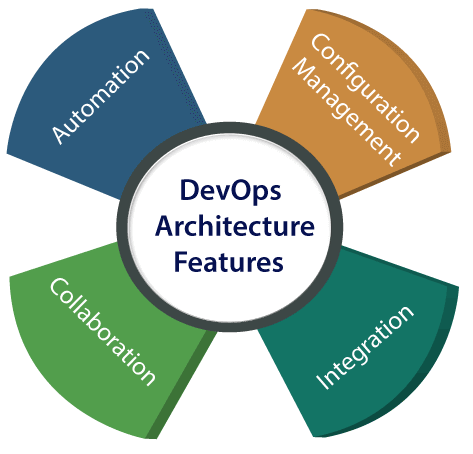The DevOps is the combination of two words, one is Development and other is Operations. It is a culture to promote the development and operation process collectively.
The DevOps tutorial will help you to learn DevOps basics and provide depth knowledge of various DevOps tools such as Git, Ansible, Docker, Puppet, Jenkins, Chef, Nagios, and Kubernetes.
What is DevOps?
The DevOps is a combination of two words, one is software Development, and second is Operations. This allows a single team to handle the entire application lifecycle, from development to testing, deployment, and operations. DevOps helps you to reduce the disconnection between software developers, quality assurance (QA) engineers, and system administrators.

DevOps promotes collaboration between Development and Operations team to deploy code to production faster in an automated & repeatable way.
DevOps helps to increase organization speed to deliver applications and services. It also allows organizations to serve their customers better and compete more strongly in the market.
DevOps can also be defined as a sequence of development and IT operations with better communication and collaboration.
DevOps has become one of the most valuable business disciplines for enterprises or organizations. With the help of DevOps, quality, and speed of the application delivery has improved to a great extent.
DevOps is nothing but a practice or methodology of making "Developers" and "Operations" folks work together. DevOps represents a change in the IT culture with a complete focus on rapid IT service delivery through the adoption of agile practices in the context of a system-oriented approach.
DevOps is all about the integration of the operations and development process. Organizations that have adopted DevOps noticed a 22% improvement in software quality and a 17% improvement in application deployment frequency and achieve a 22% hike in customer satisfaction. 19% of revenue hikes as a result of the successful DevOps implementation.
Why DevOps?
Before going further, we need to understand why we need the DevOps over the other methods.
- The operation and development team worked in complete isolation.
- After the design-build, the testing and deployment are performed respectively. That's why they consumed more time than actual build cycles.
- Without the use of DevOps, the team members are spending a large amount of time on designing, testing, and deploying instead of building the project.
- Manual code deployment leads to human errors in production.
- Coding and operation teams have their separate timelines and are not in synch, causing further delays.
DevOps History
- In 2009, the first conference named DevOpsdays was held in Ghent Belgium. Belgian consultant and Patrick Debois founded the conference.
- In 2012, the state of DevOps report was launched and conceived by Alanna Brown at Puppet.
- In 2014, the annual State of DevOps report was published by Nicole Forsgren, Jez Humble, Gene Kim, and others. They found DevOps adoption was accelerating in 2014 also.
- In 2015, Nicole Forsgren, Gene Kim, and Jez Humble founded DORA (DevOps Research and Assignment).
- In 2017, Nicole Forsgren, Gene Kim, and Jez Humble published "Accelerate: Building and Scaling High Performing Technology Organizations".
DevOps Architecture Features
Here are some key features of DevOps architecture, such as:

1) Automation
Automation can reduce time consumption, especially during the testing and deployment phase. The productivity increases, and releases are made quicker by automation. This will lead in catching bugs quickly so that it can be fixed easily. For contiguous delivery, each code is defined through automated tests, cloud-based services, and builds. This promotes production using automated deploys.
2) Collaboration
The Development and Operations team collaborates as a DevOps team, which improves the cultural model as the teams become more productive with their productivity, which strengthens accountability and ownership. The teams share their responsibilities and work closely in sync, which in turn makes the deployment to production faster.
3) Integration
Applications need to be integrated with other components in the environment. The integration phase is whore the existing code is combined with new functionality and then tested. Continuous integration and testing enable continuous development. The frequency in the releases and micro-services leads to significant operational challenges. To overcome such problems, continuous integration and delivery are implemented to deliver in a quicker, safer, and reliable manner.
4) Configuration management
It ensures the application to interact with only those resources that are concerned with the environment in which it runs. The configuration files are not created where the external configuration to the application is separated from the source code. The configuration file can be written during deployment, or they can be loaded at the run time, depending on the environment in which it is running.
DevOps Advantages and Disadvantages
Here are some advantages and disadvantages that DevOps can have for business, such as:
Advantages
- DevOps is an excellent approach for quick development and deployment of applications.
- It responds faster to the market changes to improve business growth.
- DevOps escalate business profit by decreasing software delivery time and transportation costs.
- DevOps clears the descriptive process, which gives clarity on product development and delivery.
- It improves customer experience and satisfaction.
- DevOps simplifies collaboration and places all tools in the cloud for customers to access.
- DevOps means collective responsibility, which leads to better team engagement and productivity.
Disadvantages
- DevOps professional or expert's developers are less available.
- Developing with DevOps is so expensive.
- Adopting new DevOps technology into the industries is hard to manage in short time.
- Lack of DevOps knowledge can be a problem in the continuous integration of automation projects.
No comments:
Post a Comment